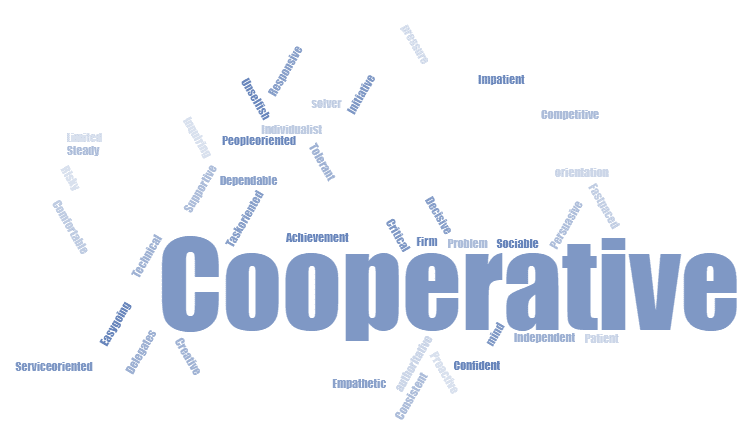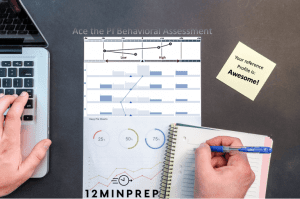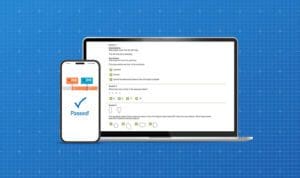Gideon here from 12minprep. Today I’m going to explain to you all you need to know about the PI behavioral assessment, including free preparation tips, sample questions, best practices, understanding your score/result and much more.
For many of you, taking a personality test is a daunting task, as you’re not sure what the employer may reveal about you and how it will affect your application and interview process.
I totally understand these feelings and I believe there’s a way to cope with them, and that’s what I’m going to try and do in this lesson: We’re going to go over some test essentials, preparation tips, and best practices to maximize your PI behavioural assessment.
*spoiler – no cheating involved **Disclaimer – opinions are my own
Table of contents:
| 1 How does the PI behavioral assessment work? |
| 1.1 PI behavioral assessment results |
| 1.2 Sample questions (sample words to be precise) |
| 2 How to prepare for the assessment? |
| 2.1 How many adjectives to choose? |
| 2.2 Which adjectives to choose? |
| 2.3 Should adjectives on the two lists be different? |
| 2.4 Crossing between job description and PI reference profiles |
| 3 The interview in light of PI results |
| 4 The PI cognitive assessment |
How does the PI Behavioral Assessment Work?
The Predictive Index behavioral assessment is a very popular work-related behavioural assessment, taken by 2.5 million candidates each year. Most candidates complete this assessment within less than 10 minutes.
It introduces a free response format that asks you to fill in two identical checklists of 86 adjectives.
On the first checklist, you’re asked to pick adjectives that describe the way you are expected to behave by others, also known as self-concept. Self-concept is how you may be adapting your natural behaviors to the expectations of your current work environment. This is subject to change and in fact the PI claims that the responses here are only valid for a few months each time.
On the second list of adjectives, you’re asked to pick adjectives that simply describe you, also known as self. Self reflects your core, native drives.
I can tell you from personal experience and from talking to many candidates, that the assessment is very accurate. I personally got a Persuader profile which is in line with many of my behaviours and needs.
Being a free choice assessment, the PI is a very friendly assessment. You select only what you feel applies to you, as opposed to being required to pick an answer from a list of choices, which is how most classical personality assessments work.
What’s important to acknowledge is that what you select, or don’t select, how much or how little you select, all reveals a lot of relevant data to the employer. And this brings us to the essence of this lesson. I’m not going to teach you how to cheat on this test, but I’m going to help you follow some common sense guidelines which I believe are crucial.

PI Behavioral Assessment Results
Upon submission, your responses will be analyzed and translated into what’s called Synthesis, which is basically how you perform on the job.
The combination of the two questionnaires is what helps employers understand how you manage your behaviour given the natural gap between who you and the environment. Your synthesis will be matched with one of the 17 available PI profiles, which try to describe your drives and needs in a workplace. It will also be crossed with the specific profile that was pre-built by the employer. There are high chances that you’ll be given your reference profile upon submission of the assessment, but this changes from one employer to another.
The profiles are built upon the relationships between four main factors or drives:
Factor A: Dominance – the drive for impact
Factor B: Extraversion – the drive for social interaction
Factor C: Patience – consistency and stability
Factor D: Formality – conforming to rules and structure

There are also two additional factors that are taken into account in your profiling which are:
Factor E: How emotions take part in decision making, i.e. whether you’re objective or subjective.
Factor M: Your response levels. More on this one in the coming paragraphs.
Sample reports
I highly recommend having a look at those sample reports.
John Doe detailed report 1, report 2 – must see
The placard – companies that use the PI are advised to attach those behavioral profiles to each worker’s cubical. A pretty cool concept!
Sample Questions (Sample Words)
There are no questions on the PI behavioral assessment, so there aren’t really any sample questions I can show you. But, there are lots of words, more accurately adjectives, that one can be familiar with, in order to better understand how those adjectives reflect different intensities of the four drives measured by the PI.
Let’s look at which words can describe each of the drives:
Dominance: the drive for impact. Can be expressed through the following words, from low to high:
Compliant → Supportive, Collaborative → Determined, Assertive → Forceful
Extraversion: The drive for Social Interaction
Private → Reflective → Sociable → Influential
Patience: The drive for consistency and stability
Rushed →Tense → Calm → Easy-going
Formality: The drive for conforming to rules and structure
Impulsive → Flexible → Serious → Strict, Vigilant
*On this webpage, seen on a recruitment agency’s website, you will find a screenshot of the real adjectives showing up on the assessment, if you’re curious.

How to Prepare for the Assessment?
My first recommendation to you is that prior to taking the PI behavioral assessment as part of the selection process you’re facing, make sure to take a personality test that will give you a better understanding of what these tests say about you. I’ve curated some relevant resources for this purpose:
Myers Briggs test (MBTI), Truity’s MBTI, 16PF test, Jung personality test
Free PI behavioral assessment offer – yes, you read it right! If you have a business email, you can take the PI behavioral assessment in advance, for free!
Generally speaking, all known and esteemed personality tests measure the 4 factors that are measured by the PI, they simply may be given different names.
Upon receiving the results of such a test, ask yourself – did it manage to spot and map some of your personality traits to a good extent? You can share this report with a close friend or family member to see if they agree with the results too. That will help you acquire an objective perception of your candidate profile and will also help you reflect on the adjectives that could describe such a profile.
In addition, doing this will take you a step forward in preparing for your interview, and we’ll discuss this in greater detail in a few minutes.
If you want to deep-dive even further into the test’s methodology, I recommend to complete reading my article and then heading over to these videos on Youtube:
How many adjectives to choose?
There are 86 adjectives on each of the two lists and it is important that you don’t pick too little nor too many.
Technically speaking, if you choose less than 6 adjectives on each list, or more than 80 adjectives on each list, you’re going to compromise the statistical validity of the assessment and this might result in extreme patterns. The employer or practitioner receive a detailed score report that mentions how many adjectives you marked and they will take this into consideration if they see extreme patterns in your profile. In such extreme cases, the employer might even ask you to take the test again.
The number of adjectives you mark is referred to as M factor, where M stands for Morale, the response level. While having no direct impact on factor analysis, if you mark too little adjectives, it might imply on how much you are likely to engage with the workplace. To quote a PI professional:
If someone selects fewer words from the checklist, either due to not knowing what some words mean or thinking that those words do not describe him or her or what is expected of him or her, the person is simply reacting to the PI environment as he or she would react in the actual workplace environment.
In addition, in another PI webinar that’s available on YouTube a PI professional referred to those M values as indicators of stress and even energy levels! When the difference between the number of adjectives marked on each list were big, the stress level was referred to as high. Meaning there’s something about the job you’re doing at the moment which puts you out of balance.
Bottom line, try to pick a reasonable amount of adjectives on each list, anywhere between 20 to 50.
Which adjectives to choose?
A trait will be observed as characteristic of you if you choose enough adjectives that belong to it.
For example, if a candidate marks many words that describe social needs such as talkative, persuasive, influential, open) then their self-pattern will be described as an extrovert which is fine and a required trait in many jobs, especially managerial and influential jobs.
But even within the social scale, there are different ways one can express their social behaviour.
If you choose many and extreme words like compelling, influential, appealing, desirable, then your Extroversion factor will be marked as extreme, which might in certain cases imply that you’re sometimes too talkative and even superficial.
Thus, if there’s a trait which you feel describes you, and you know it is important for the job in hand, make sure to mark more than one or two adjectives that describe it, and be aware of extremities.
Another point to notice is that if you go and mark only very few to single adjectives that describe a certain trait, your Self profile will come out flat (image). Such a Self-profile might imply that you’re a “hard to read” person. The problem with such an outcome is that interviewers who look at your profile might want to have you run through more interviews than usual, just to make sure they “read“ you correctly.
To have a better understanding of how different adjectives relate to different behaviours, please refer to the links I’ve added in the bottom of the video (Continuums of Expression)
Should adjectives on the two lists be different?
Generally speaking, there is no problem with marking different adjectives on each list. It’s very natural to have differences between the two states and different jobs will require us different behaviours. As long as we know how to manage the expectations without it taking a heavy toll from us, it’s fine.
But consider these two important situations.
- If the differences between the adjective lists are extreme, this will raise a flag.
In cases whre the two lists show completely different personas, the employer may wither decide to not go with this candidate’s profile, or they may want to understand how much stress is accumulated in managing this gap. They will do it by asking relevant interview questions.
Here’s an example question that you might hear if your PI report came out as having very different self and self-concept outcomes:If your current employer could make the job the perfect place for you, how would it be different from where it is today?
- If the job you’re applying to is similar to your current job, extreme differences will imply an inferior fit for the job. It is apparent that you’re currently coping with a gap between who you are and what the job requires. If the gap is extreme ,this definitely comes at a cost. One employer may decide to clarify this in an interview, another may just move on to the next candidate.
To summarize this point, it’s all about balance: avoid extremities between the two lists!
Crossing between job description and adjectives
I thinks it’s very important to perform an in-depth research on your job, employer, and skills and personality traits required for it. Once you have this information (employer’s career website, Glassdoor, friends and colleagues, the job description) go ahead and browse through the PI reference profiles to see which one is best in line with the job. Look for the adjectives that make up this profile and ask yourself if they are in line with your own natural drives and/or whether you know how to express them without it becoming too stressful for you.
For example, the reference profile of a Captain looks like this:
Very high dominance
High extroversion
Low levels of patience
Moderate levels of formality
If you’re applying for a job that’s geared towards managing people or processes in a very social environment, with deadlines etc, then you obviously cannot expect that marking many introvert-like adjectives on the Self list will contribute to your application chances.
Please note, this is not about cheating. It’s about knowing which of your traits, given that you hold them, should be stressed out and prioritized in the given job.
One could claim, “just because I don’t have that trait in my DNA doesn’t mean I can’t adapt to performing it.” And that’s a valid point, but the question is at what price. If the gap between you and the job creates tremendous amounts of stress, then a new employer might prefer to hire someone who’s more natural for the job.
The Interview in Light of PI Behavioral Results
The PI behavioural assessment is just one tool among many that employers use to understand who you are. It becomes a powerful tool when coupled with an interview. The employer looks at your behavioural profile and designs the interview to clarify and confirm that indeed the profile is in line with reality.
Companies that use the PI usually conduct a behavioural interview. I will not go into the details of behavioral interview questions, but I will stress out that you should prepare accordingly, and I’ve added links to interview guides which the PI company hands over to employers and hiring managers, to help them construct better interviews. Those guides are a great way to prepare for certain interview questions, because you can see which questions are referring to which factors (extraversion, dominance, etc.)
♦ PI’s official Interview guide – highly recommended
♦ Advisa’s PI interview questions guide – really good stuff with questions grouped according to trait/skill
The PI Cognitive Assessment
Lastly, I would like to mention that the majority of employers who use the PI behavioural assessment also ask candidates to take the PI cognitive assessment. I offer free and paid practice resources for the cognitive assessment, which were used by tens of thousands of candidates to date. I highly recommend that you pay a visit to my website, take my free introduction course, and use the endless resources I provide there for maximizing your score potential on the PI cognitive assessment:
♦ Free predictive index test sample
♦ PI cognitive assessment prep course
♦ Free intro course to cognitive ability tests
That’s it, I hope this was helpful and that you’re able to look positively at discovering who you are, and to act on these findings to optimize your application process and interviews.
Feel free to use the comments and reviews box at the bottom to ask questions.
Sincerely,
Gideon
Founder at 12minprep















Comments
great stuff
Much useful
Very useful
Very informative
Great Article!
Happy to be of help!
🙂